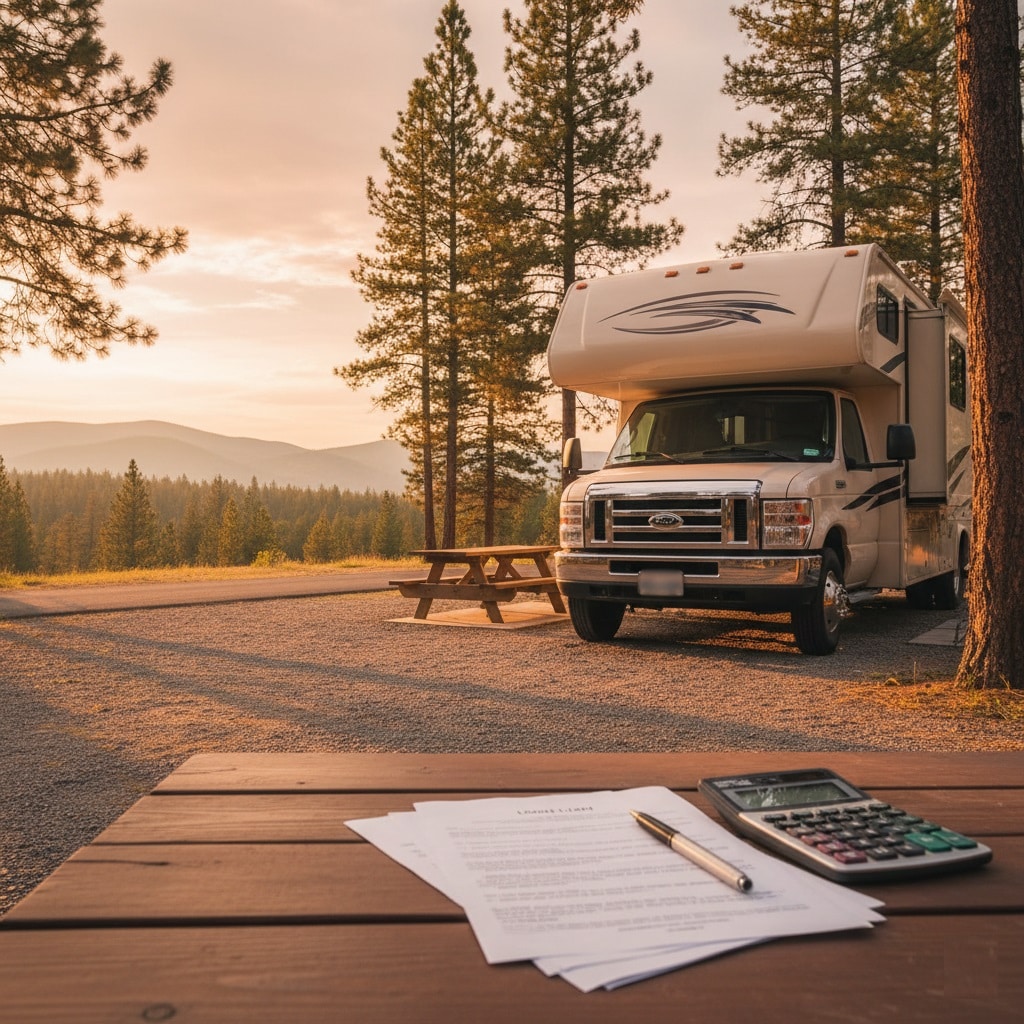You can finance an RV with a bad credit score. Approval comes down to risk: show steady income, put cash down, and choose an RV that holds value. This guide explains rv camper financing options, what lenders check, how to lower your rate, and a simple plan to follow—even if past mistakes hurt your score.
Can you get an RV loan with bad credit?
Yes. Many credit unions, banks, and specialty lenders will consider applicants with imperfect histories. Expect tighter terms: a larger down payment, a shorter term, or a higher APR. A clean, complete file and a realistic budget make the difference.

What lenders look at (and how to improve each)
- Credit history: Recent on-time payments help more than you think. Bring proof if you settled old collections or disputes.
- Debt-to-income (DTI): Lower is better. Paying down a credit card or auto loan before you apply can tip DTI in your favor.
- Down payment: For rv financing, plan 15–25% if credit is weak; more down = lower risk and often better offers.
- The RV itself: Mainstream models and newer units book stronger. Camper trailer finance is often simpler than very old motorhomes.
- Income stability: Two years with the same employer (or steady contracts) is a plus. Bring pay stubs or bank statements.
Loan paths that work with bad credit
- Secured RV loan (most common): The RV is collateral. Works for motorhomes, travel trailers, fifth wheels, and campers.
- Credit union financing: Often friendlier underwriting and member discounts; check local eligibility.
- Dealer financing: Fast in-store approvals; compare APR + fees to your pre-approval.
- Co-signer/co-borrower: A stronger profile can unlock lower APRs—only if both parties are comfortable with full responsibility.
- About “rv mortgage” wording: Lenders sometimes market “mortgage-style” RV loans, but RVs are usually titled as vehicles, not real property. Ask how the lien, taxes, and interest treatment work in your state/province.
Quick wins before you apply
- Target the right price: Pick an RV that keeps payment + insurance + storage within your budget.
- Build a bigger down payment: Sell unused gear, trade a vehicle, or save until you reach 15–25%.
- Tighten the term by a year: Slightly higher payment, lower lender risk—often better approval odds.
- Fix small credit drags: Dispute clear errors, pay tiny balances, set all bills to autopay.
- Line up insurance early: Some lenders want a binder at signing.
Payment math you can copy (illustrative)
Use these to stress-test your budget; these are examples, not offers.
Travel trailer
- Price: $28,000 | Down: 20% ($5,600) → Financed: $22,400
- 72 months at a mid-teens APR → ~$450–$500/month
Class C motorhome
- Price: $58,000 | Down: 20% ($11,600) → Financed: $46,400
- 84 months at a mid-teens APR → ~$740–$820/month
Rule of thumb: If the payment squeezes your budget, raise the down payment, shorten the shopping list, or choose a shorter term once your credit improves.
Quick Checklist for Bad Credit RV Loan Applications
- Step 1: Check your credit reports from all three bureaus for errors
- Step 2: Calculate 20-30% down payment based on target RV price
- Step 3: Gather two years of tax returns and recent pay stubs
- Step 4: Research lenders specializing in bad credit RV loans
- Step 5: Get pre-qualified with 3-5 lenders without hard credit pulls
- Step 6: Compare total loan costs, not just monthly payments
- Step 7: Negotiate with dealers using your pre-approval letters
- Step 8: Read contracts carefully before signing
- Step 9: Set up automatic payments to rebuild credit
US vs Canada: what changes
United States
- Sales tax and registration are handled at your DMV/Tag office; some states use electronic liens/titles (faster).
- Insurance rules differ for motorhomes vs towables—get a quote before you sign.
Canada
- Taxes at registration depend on province (GST/HST/PST).
- Provincial lien searches (PPSA) and used-vehicle transfer forms apply for private sales.
- Some lenders cap the RV’s maximum age at funding; ask before shopping vintage rigs.
Private party vs dealer: which is safer with bad credit?
- Dealer: Fast funding; they handle payoff/title and may have lender partners open to bruised credit. Prices are often higher.
- Private party: Better pricing, more paperwork. If you need financing, confirm your lender allows private-party purchases and agree on a clean payment process.
Mini case study
Jordan’s score sits in the low 600s after a rough year. He wants a used travel trailer for weekend trips. He saves 20% down, pays off a small credit card, and gets pre-qualifications from a local credit union and a national specialty lender.
The credit union offers a slightly lower APR with 72 months; the specialty lender approves 84 months but at a higher rate. Jordan chooses the 72-month path, keeps his payment under target, and sets autopay to rebuild credit—planning to refinance in 12–18 months.
Frequently Asked Questions
What’s the absolute minimum credit score for RV financing?
Some specialized lenders approve scores as low as 500, though most require at least 550. Scores below 580 typically need 25-35% down payments and face interest rates above 15%. Consider working on credit improvement if your score falls below 550.
Can I get an RV loan with a recent bankruptcy?
Chapter 7 bankruptcy requires waiting 12-24 months after discharge before most lenders will consider your application. Chapter 13 bankruptcy might allow financing while still in repayment if you’ve made 12 months of on-time payments and get court permission.
How much will bad credit increase my RV payment?
Bad credit typically adds $75-150 to monthly payments on a $30,000 loan compared to good credit rates. A 15% interest rate versus 6% increases a $25,000 ten-year loan payment from $278 to $403 monthly.
Should I use a co-signer for my RV loan?
Co-signers dramatically improve approval odds and interest rates for bad credit borrowers. Your co-signer needs good credit (usually 650+) and becomes fully responsible if you default. Only ask someone who completely understands these risks.









